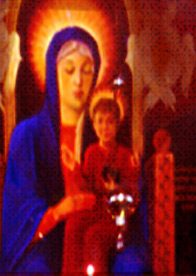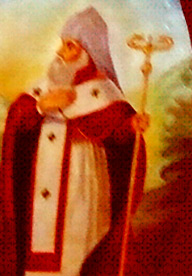Kayseri and Armenians
City of Kayseri plays a very important role in the history of Armenian Church. With 400.000 population in 250 AD. İt became the most important of Middle Anatolia. Yet it means more than this to Armenian community since Kayseri is the city where Surp Kirkor was raised, studied and adopted Christianity as his religion.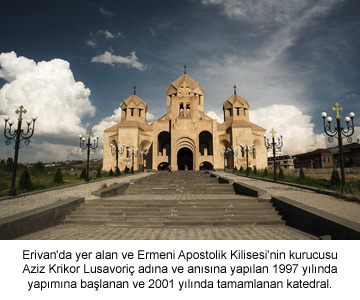
Every society has their own holly lands. If Mecca is considered sacred for Muslims, Kayseri, by being the city where the church was established is considered sacred for Armenians and a place of pilgrimage.
After adopting Christianity himself Kirkor then went to Armenia and became an influence over the king,princes,army and the nation to embrace the religion. King Dırtad sent him to Kayseri and he became the first Armenian Patriarch in the beginning of 4th century.
The 84th Patriarch of Turkey Armenians, Mesrob Mutafyan explains St. Kirkor's life and the importance of Kayseri in one of his statements that;
In 361 Kayseri continued to be a very efficient religion center in Greek-Armenian geography. It stil played an important role in assigning religion leaders for Armenian Community even after St Kirkor Lusavoric. His sons Arisdages and Virtanes, Husig (son of Vırtanes) , Nerses (from the same blood) became Armenian Catholicos with approval of Kayseri archbishop.
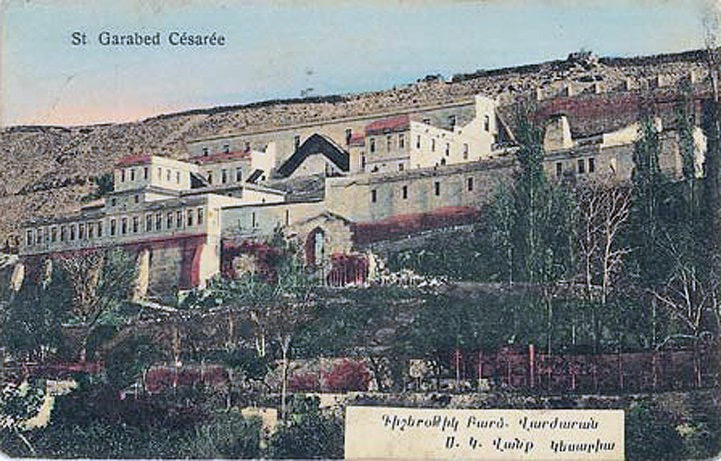
Surp Garabed Monestry
The spiritual center for Kayseri Armenians was in Efkere inside the Surp Garabed Monestry.(In the present it is in Bahceli district in Gesi.)
It was where a part of the baptizer Yahya's bones were found and the monestry was built by St.Thaddeus in the 4th century.This monestry was built upon a hill and was a very important pilgrimage point.In this monestry there was a caravansaray, a library with 200 writings and 20.000 books and a seminary that provided highest level of education.
Armenians In The Time Of Ottoman
In his book,Evliya Celebi states for Kayseri that: "Pastrami and sujuk of this city go to Sultans as gift. It is located by Mount Erciyes so the climate is cold. The people are fit and couregous.The educated ones speak Farsy and Arabic but Turkish is the common public language. You hear Armenian spoken but neither Greek nor Kurdish.In Boyacıoglu gate you find Karakas the Armenian doctor who is a very talented surgeon.He has completed his studies of Medicine in Spain. He has a blue water for toothaches and a red water to take this tooth out with your bare hands.From the beginning of 17th century Kayseri started to become known in the markets of Amsterdam and Venice with its Armenian traders. The armenians were ahead not only in trade but also in manufactering. In such an early date as 1856 the textile factory that was built by Hasırcıyan brothers carried 300 weaving stalls.The carpets and fabrics weaved and produced by Kayseri Armenians found a tremendous amount of buyers even in foreign markets. The ones who lived in high plateus during summer were famous with the fruit they grew and the wine they produced. It has been with Armenians' effort and hard work that Kayseri became very famous with its pastrami and sujuk since livestock industry was first held by Armenian people.
In brief, Armenians played the major role in improvement of Kayseri's trade.
In 1700s Armenians did not serve for military instead they paid jizya tax and tribute to the state. Their outfit and shoe colors were different than Muslims'.
For instance Jewish and Armenian community used to wear shoes in black and purple color, Greeks wore red and the muslims especially the wealthy class wore yellow.There was a primacy in Kayseri which was subsidiary to Istanbul Patriarchate.
According to 1914 Ottoman census of population there were over 50.000 Armenian living in Kayseri. In the city center there were 3 churches along with schools that belonged to Orthodox Armenian community. Those were; Surp Sakis Church (Hagopyan School), Surp Asdvadzadzin Church (Hagyan School) Surp Kirkor Lusavoric Church ( Gumusyan and Aramyan School).
According to census carried out by the Armenian Patriarchate between 1901-1902, it was identified that there were 42 Armenian Schools with 3795 male and 1140 female students and 125 teachers.
The city had a very advanced cultural life. Armenians had their own theatre groups and a press that published weekly magazine Dikris in 1907, weekly newspaper Sepor in 1910 and weekly magazine Nor Serunt in 1912.
In Yukarı Talas district there were mansions that belonged to rich Armenians. Kalust Gulbenkyan, one of the most famous Armenians who was an oil king and a generous donator has roots of his ancestors in this region.
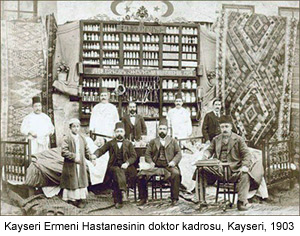
Armenians took part in municipality organization too. In 1906 during presidency of Dr. Mustafa Hilmi, the assemblymen consisted of;
• Şeyh İbrahim Efendi
• Hoca Hacı Hilmi Efendi
• Müftü Hacı Enver Efendi
• Kösehalilzâde Emin Efendi
• Dr. Karabet (Armenian)
• Dr. Manukyan (Armenian)
• Kalpağı Güdük (Armenian)
In 1914, one of the deputies in the Ottoman Parliament representing Kayseri was an Armenian called Karabet Tomayan.
Over 50.000 Armenians who played crucial role in Kayseri's economical life were forced emigration in 1915. ( The number of people that were forced emigration appeared in Talat Pasa's personal diary was 47.617.)

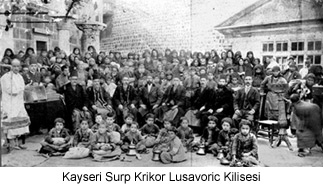
Some of the regions and districts where Armenians used to live were; İslim Paşa, Hasünlü, Samur, Neseb Hatun, Tac-ı Kızıl, Ekidere, Bahçebaşı, Bahçe, Batman, Büyükoduncu, Caferbey, Çakoloz, Çivicibektaş, Dadırharput, Gürcü, Fırıncı, Hacı Kasım, Hacı Mansur, İsaağa, Karakürkçü, Keklik, Kiçikapı, Konukboğan, Köyyıkan, Mermerli, Merkepçi (Mürekepçi) Mustafa Necip, Rum Sultan, Rumyan, Sasık, Selaldı, Sisliyan, Sultan, Süleyman, Şarkiyan, Şuturban, Tavukçu, Tomarza, Varsak, Talas, Zincidere, Germir, Gesi, Efkere, Derevan, Mancınsın, Mumcusun, Erkilet, Develi, İlibe, Çomaklı, İncesu, Cücün, Taşhan, Gömedi, Çayıroluk, Yenice.

Armenians In The Time Of Rebublic
After declaration of republic, because of demographic, social,economic and cultural changes in city life, Armenian community started to migrate to western part of Turkey.
In 1965 an interwiew made with the priest of Surp Lusavoric Church exposes there were only 130 households left in the city that belonged to Armenians and that number was way too low even when compared to past few years.
According to his observations, the church and the community linked to it had become a layover station for the ones who were willing to do some savings before moving to Istanbul.
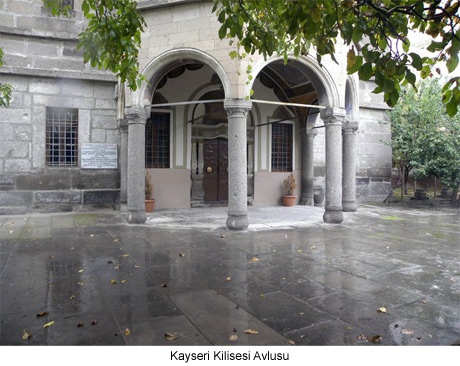
In the present day, except for a few households, there does not exist an assembled Armenian community in Kayseri. There are faith visitations organized by Istanbul Armenians to Surp Kirkor Lusavoric Church twice a year. Many Armenians from different parts of Turkey and abroad participate to these visits as well.
In 1965 an interwiew made with the priest of Surp Lusavoric Church exposes there were only 130 households left in the city that belonged to Armenians and that number was way too low even when compared to past few years.
According to his observations, the church and the community linked to it had become a layover station for the ones who were willing to do some savings before moving to Istanbul.

The history of Turkey Armenians stands back to 3000 years in this territory and as the most crowded Christian community of Turkey, Istanbul Armenians rely on republic's bright future and look forward with hope.
| Bibliography | |
| Tarihçi Arşag Alboyacıyan (1879-1962) | Geniş Kayseri Tarihi, Halit Erkiletlioğlu |
| 100 Yıl Once Turkiye'de Ermeniler (Osman Köker ,Birzamanlar Yayıncılık) | Kayseri ve S. Krikor Lusavoriç Kilisesi (Türkiye Ermeni Patrikliği , 1986) |
| 1965 yılında kayseri ermeni cemaati(Rıfat N. Bali) | Evliya Çelebi Seyahatnamesi (NTV Tarih Sayı 23) |
| Talat Paşanın Evrak-ı Metrukesi (Murat Bardakçi) | Kayseri Büyükşehir Beldiyesi Web Sayfası |
| http://www.milliyet.com.tr/2006/10/24/yazar/uras.html | http://www.ardost.com/turkiye/kayseri/kultur1.htm |
| http://www.erciyestv.com.tr/yazar_detay.php?id=106 | http://www.virtualani.freeserve.co.uk/kayseri/turkish.htm |


